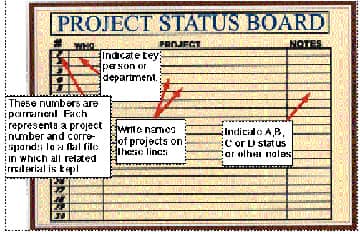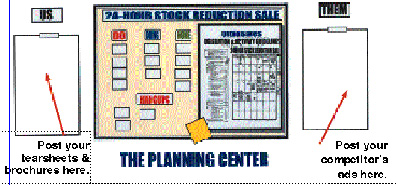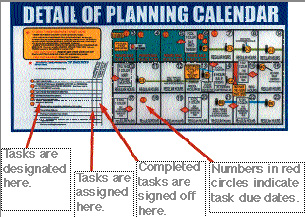The art of planning an event with vision follow-through
I never saw an effective coach - or player for that matter - who was not a good planner and a constant learner. When you think you are green, you keep growing. When you think you are ripe, you begin to get rotten." - Vince Lombardi
Planning, or the lack of it, can make or break you as a retailer. It is true that "Without vision, the people perish." Yet without a plan, a vision is just a dream; simply wishful thinking. Planning is the process that makes a vision happen. Planning may not be as glamorous and intriguing as some parts of retailing, but understanding it completely will give you an edge over almost all of your competition. Why? Because your competition is probably just going through the motions and not really planning. Authentic planning is virtually a lost art. If you are young and hungry, (or old and hungry) and want to make your mark as a furniture retailer, this article may be the most important you will ever read.
I talk to many young lions in the furniture industry. Many of the newer generation of CEO's in the furniture business understand the need to plan wisely, to sell their plan to their staff with passion, and to relentlessly strive to keep their plan alive. An important number of young entrepreneurs admit they need help in mastering these critical skills. In contrast, too many of the veteran furniture CEO's are confident that flooding the media with lots of weak ads and tired commercials will continue to hold their market share. Too often they imagine they are planning when they are really doing the same thing in about the same way year after year. Very little energy and time is put into new ideas, and very little effort is made to sell the staff on a new plan. Finally, feedback is neither earnestly asked for nor carefully considered. For this reason, an aspiring furniture retailer with a young attitude has an opportunity to make authentic progress in market penetration through the planning techniques in this article.
As a modern leader, you have three clear tasks in the planning process.
- It is your job to come up with a Master Strategy – a Plan.
- It is your job to inform and inspire the staff with your Master Strategy, to sell them on it, and to make sure they buy into it.
- It is your job to keep the staff informed, inspired and sold. This article will explain how to do all three of these things in the fastest, most efficient way.
THE MASTER STRATEGY
Let's imagine you want to run a special mattress promotion and capture many new mattress customers. Your vision is clear. You want a complete, selling program that is fresh and exciting. You know there is a big universe of customers out there who delayed buying a new sleep set and continue to procrastinate. You know that, statistically, folks wait from three to five years or more after they notice mattress wear before they take action and buy.
You also know the competition in your city is running very weak, look-alike mattress ads. Most ads seem to assume that people buy mattresses only because they don't have to pay for them for six months or a year. They are generally ugly and scream price. Yet, as a commodity, mattresses are a "sack of sand." People don't know what is inside of them. None of your competition is telling them. People don't know what significance the different names on mattress sets have, nor why one mattress costs more than another. None of your competition is telling them. They just list prices.
So, your vision is to run a great mattress promotion. To turn this vision into reality, you first have to put it on paper, you must create a calendar. I have designed a special calendar that allows me to do a complete plan and delegation sequence. The squares are large and blank, and I fill in the dates and hours of the promotion. On the left side of this calendar and delegation guide I have a list of all the different things that need to be done to pull the sale off. These are keyed to certain dates on the calendar and assigned to specific people. I call this calendar my Delegation and Activity Calendar. Note the thoroughness and detail of the calendar on pictured below. I will explain later in this article how this calendar is used to delegate and follow-up.
SELLING THE MASTER PLAN TO THE STAFF
The first step in selling your plan is having a Team Leader Master Strategy Executive Meeting. All your key players, your Team Leaders, will be at this meeting. (These ideas are designed for a medium sized store, smaller stores can adjust them to fit their needs.) During this meeting you will Delegate Tasks and record them on your Delegation & Activity Calendar.
Note: Do not post the Delegation & Activity Calendar in an area of general traffic where road reps can see it.
A productive planning meeting is the keystone of a successful promotion. A good meeting is assured if you follow these suggestions:
- Have your Delegation & Activity Calendar ready, with preliminary information filled in as much as possible.
- Have an agenda and stick to it. Make copies and pass them out to each participant several days before the meeting.
- Make notes during the meeting, and be sure all participants get a copy of these minutes.
- Get an easel and a large pad to record ideas. Have someone record the ideas after the meeting and distribute with the minutes.
- Use modern interactive discussion methods as you record ideas. Ask questions that stimulate discussion. Instead of just answering questions quickly, first ask participants what they think. Draw them out by addressing them personally. Before you record an idea, pause and ask for feedback from the group. These simple ideas will knit the group together and form a genuine team.
- Begin with a brief description of WHY you called the meeting and WHAT you intend to accomplish by having it. The next step will be a specific and detailed delegation of each task on the Delegation & Activity Calendar. Plan a follow-up meeting scheduled on your calendar to verify that everything is tracking correctly. Check all delegated items.
KEEPING EVERYONE INFORMED & INSPIRED
Follow-up meetings keep the ball rolling and keep people informed. I recommend up to three executive meetings in the two weeks just prior to the event. In these meetings you check progress. If you are a larger store, you will also need a general meeting early on, and a general meeting on the first day of the event. The calendar design allows people to sign off on completed items. As you review the list, you can up-date progress.
EXECUTIVE BRAIN STORMING
AFTER you have given the first executive staff meeting (for your Team Leaders) they will have an idea of your vision of this promotion. Later in that meeting, or in an early follow-up meeting, consider having a brain storming session to really get things moving. Get important input from everybody. This brainstorming early in the game allows the staff to have a say; they begin to "get into" the sale. To develop an inspired group, they must "own" a part of the plan.
There are only three rules to great brainstorming, but you must follow them faithfully and without exception.
'RULES' FOR SUCCESSFUL BRAINSTORMING
Make a simple sign with these rules on it and post it before beginning the session.
- No one can criticize any idea.
- Each idea belongs to everyone... so you can "hitchhike" your ideas on someone elses.
- You can come up with ways of "plusing" or improving someone else's idea.
That's the idea. Try it, and encourage the team leaders to use it with their teams. It's fun, exciting, and will generate great ideas and build terrific teamwork.
Remember, brainstorming is fun, loose, uncontrolled, and best conducted after, and clearly separate from, the more formal delegation and operational discussions.
GENERAL MEETINGS TO BUILD MOMENTUM
A general staff meeting includes everyone who will have a part in the sale. At least two general meetings before the sale are recommended: One overview meeting soon after the first Executive Meeting, and one the day before sale day (before the Private Sale). The first meeting is conducted after all of the Team Leaders have met with their teams. It does not have to be a long, drawn-out meeting. It should be fast moving and all the Team Leaders can contribute.
FINAL GENERAL MEETING, DAY OF PRIVATE SALE
For the final general staff meeting before the sale, brief everyone on advertising, merchandise, procedures, and policies. Show the kickoff ads and the Preferred Customer letter; tell the staff how important each element of execution will be to the success of the promotion. Announce any special contests for the support people; pass out sales kits (see illustration below.)
This final meeting takes place about an hour or so before opening. Walk the sales people through the store, locate merchandise that is advertised. Show the actual tear sheets of the ad, make sure they are posted on the doors. Last minute checks: Security on hand? Extra personnel? Person delegated to open door and save door sign? Trouble shooter briefed and ready? Is radio being monitored to be sure it is being correctly run?
FINAL 15 MINUTES OF LAST GENERAL PRE-SALE MEETING
The excitement begins to build! Now is the time for nothing but positive thought and execution. Everything has been prepared; now is the action moment. Whatever you do or say, be sure the entire staff is smiling and positive when the doors open. Announce any last-minute news. Remind the staff about the incentives. Announce a final new contest at the last minute. In a high impact event, about three minutes before the doors open, remove the butcher paper from the windows (the signs stay up.) Remove the "closed" sign from the door. Post your security man. Unlock the front doors and go for it!
CREATE A COMMAND CENTER
Few smaller retail organizations, or branch operations, have a formal conference room. Yet it is necessary to develop a center where promotion information is displayed and discussed. All that you need to create a dynamic planning center is a reasonably secure room or area, a large bulletin board, some push-pins and some 3x5 cards. The Planning Center gives executives and selected staff a visual idea of how things are going and keeps things perking along.
A PROJECT BOARD TO ORGANIZE CREATIVE WORK
It has been estimated that the average executive spends about one hour each day looking for things on his or her desk. That's more than six 40-Hour work weeks a year! Creative people, like anyone else, need meaningful time-blocks to get work done. Yet, every creative leader is hit by a constant barrage of messages, calls, notes, and material related to one of several dozen important projects. The creative mind usually copes with this by piling material up. This will happen during the work day, in our experience, no matter how organized we may be at the start of the day. Papers and materials related to specific working jobs - not necessarily the one you are working on - will be set aside.
The Project Board system will greatly reduce the number of misplaced items. The key to being organized is not new. Have a place for everything and - a plan that gets everything in its place before the day is out. The method to achieve this is one used, in one form or other, by most ad agencies. You will need:
- An erasable board with markers.
- A flat file, with ten to twenty drawers of about 14 x 25 inch size. Corrugated flat files (made for storing flat artwork or blueprints) of this kind are inexpensive, and can be ordered at a business or drafting supply house.
Have someone who prints well prepare your board as indicated in the illustration. Put the numbers in spaces as indicated. These numbers are permanent. Number the flat file drawers or the pigeon-holes to correspond to the numbering used on the board. Each numbered space will correspond to a drawer or slot. Now write each project name with an erasable marker on a numbered space.
As materials come in simply place them in the correct drawer or slot until you are ready to work on them. Keep other materials (for general filing) in a single area. At the end of each day, never fail to pick up the stacks of material you are working on and place them in their designated area. After you have mastered this system for yourself, teach it to your executives and managers. You'll discover the system saves time and provides a psychological edge. It works and it will pay off. Try it.



Larry Mullins, President of UltraSales, Inc., has 30+ years experience in the front lines of retail furniture marketing. Larry's mainstream executive experience, his creative work for "promoter-specialists," and study of advertising principles has enabled him to continually develop new High-Impact strategies for independent furniture retailers that are sound, complete, and innovative. Inquiries can be sent to Larry care of FURNITURE WORLD at editor@furninfo.com.